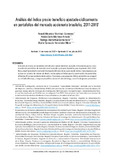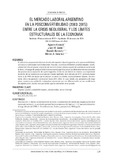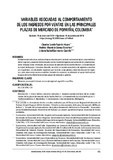Mostrar el registro sencillo del ítem
Cyclically Adjusted Price-Earnings Ratio Analysis of Brazilian Stock Market Portfolios, 2011-2019
Análisis del índice precio-beneficio ajustado cíclicamente en portafolios del mercado accionario brasileño, 2011-2019;
Análise do índice preço-benefício ajustado ciclicamente nos portfólios do mercado acionário brasileiro, 2011-2019
| dc.contributor.author | Martínez Contreras, Ronald Mauricio | |
| dc.contributor.author | Martínez Amado, Rubén Darío | |
| dc.contributor.author | Atehortúa Santamaria, Rodrigo | |
| dc.contributor.author | Hernández Mora, Nydia Consuelo | |
| dc.coverage.spatial | Lat: 06 15 00 N degrees minutes Lat: 6.2500 decimal degreesLong: 075 36 00 W degrees minutes Long: -75.6000 decimal degrees | |
| dc.date.accessioned | 2024-01-23T16:11:11Z | |
| dc.date.available | 2024-01-23T16:11:11Z | |
| dc.date.created | 2022-10-27 | |
| dc.identifier.issn | 0120-6346 | |
| dc.identifier.uri | http://hdl.handle.net/11407/8257 | |
| dc.description | This article evaluates the benefits of the cyclically adjusted price-earnings indicator for the construction of investment portfolios in the Brazilian stock market for the period 2011-2019. To meet this objective, information was taken from the value of the shares of thirty-three companies listed on the Brazilian stock exchange and the index is applied to them for the construction of efficient portfolios. The behavior of the financial assets that make up these portfolios was compared with the Bovespa index, and then the value of risk was calculated in order to generate investment portfolios with a risk equivalent to the Bovespa index. Although there are studies on the application of this indicator in various markets, there are few that focus on the cyclically adjusted price-earnings for the construction of investment portfolios and there is no evidence of the existence of this type of analysis focused on the Latin American market, hence the importance of this work. As a result, it was observed that the performance of the portfolios constructed with this methodology exceeds the Bovespa in six of the nine years analyzed; moreover, between 2011 and 2019 the portfolios constructed generated a return 3.27 times higher than the Bovespa. | eng |
| dc.description | Este artículo evalúa las bondades del indicador precio-beneficio ajustado cíclicamente para la construcción de portafolios de inversión en el mercado accionario brasileño para el periodo 2011-2019. Para cumplir este objetivo se tomó información del valor de las acciones de treinta y tres empresas que cotizan en la bolsa de valores de Brasil y se les aplica el índice para la construcción de portafolios eficientes. El comportamiento de los activos financieros que componen dichos portafolios se comparó con el índice Bovespa, y luego se procedió a calcular el valor del riesgo, con el fin de generar portafolios de inversión con un riesgo equivalente al Bovespa. A pesar de que existen estudios de aplicación de este indicador en diversos mercados, son pocos los que se enfocan en el precio-beneficio ajustado cíclicamente para la construcción de portafolios de inversión y no se evidencia la existencia de análisis de este tipo enfocados en el mercado latinoamericano, de aquí la importancia de este trabajo. Como resultado, se observó que el rendimiento de los portafolios construidos con esta metodología supera al Bovespa en seis de los nueve años analizados, además, entre 2011 y 2019 los portafolios construidos generaron un rendimiento 3,27 veces superior al Bovespa. | spa |
| dc.description | Este artigo avalia as bondades do indicador preço-benefício ajustado ciclicamente para a construção de portfólios de inversão no mercado de ações brasileiro para o período 2011-2019. Para cumplir este objetivo tomou informação do valor das ações de trinta e três empresas que invertem na bolsa de valores do Brasil e se lhes aplica o índice para a construção de portfólios eficientes. O comportamiento dos ativos financeiros que compõem ditos portfólios foi comparado com o índice Bovespa, e depois procedeu-se a calcular o valor de risco, com o objetivo de gerar portfólios de inversão com um risco equivalente ao da Bovespa. Apesar da existência de estudos de aplicação deste indicador em diversos mercados, são poucos os que se concentram no preço-benefício ajustado cíclicamente para a construção de portfólios de inversão e não se percebe a existência de análise desse tipo enfocado no mercado latino-americano, daí a importância desse trabalho. Como resultado, observou-se que o rendimento dos portfólios construído com essa metodologia supera a Bovespa em seis dos nove anos estudados, ademais, entre 2011 e 2019 os portfólios construídos geraram um rendimento 3,27 vezes maior ao da Bovespa. | por |
| dc.format | ||
| dc.format.extent | p. 1-23 | |
| dc.format.medium | Electrónico | |
| dc.format.mimetype | application/pdf | |
| dc.language.iso | spa | |
| dc.publisher | Universidad de Medellín | |
| dc.relation.ispartofseries | Semestre Económico; Vol. 25 No. 58 (2022) | |
| dc.relation.haspart | Semestre Económico; Vol. 25 Núm. 58 enero-junio 2022 | |
| dc.relation.uri | https://revistas.udem.edu.co/index.php/economico/article/view/4137 | |
| dc.rights.uri | http://creativecommons.org/licenses/by-nc-nd/4.0 | * |
| dc.source | Semestre Económico; Vol. 25 No. 58 (2022): (enero-junio); 1-23 | |
| dc.subject | Global financial market | eng |
| dc.subject | Stock market | eng |
| dc.subject | Investment portfolios | eng |
| dc.subject | Value at risk | eng |
| dc.subject | Brazil | eng |
| dc.subject | Mercado financiero global | spa |
| dc.subject | Mercado de acciones | spa |
| dc.subject | Portafolios de inversión | spa |
| dc.subject | Valor en riesgo | spa |
| dc.subject | Brasil | spa |
| dc.subject | Mercado financeiro global | por |
| dc.subject | Mercado de ações | por |
| dc.subject | Portfólios de inversão | por |
| dc.subject | Valor em risco | por |
| dc.subject | Brasil | por |
| dc.title | Cyclically Adjusted Price-Earnings Ratio Analysis of Brazilian Stock Market Portfolios, 2011-2019 | eng |
| dc.title | Análisis del índice precio-beneficio ajustado cíclicamente en portafolios del mercado accionario brasileño, 2011-2019 | spa |
| dc.title | Análise do índice preço-benefício ajustado ciclicamente nos portfólios do mercado acionário brasileiro, 2011-2019 | por |
| dc.type | article | |
| dc.identifier.doi | https://doi.org/10.22395/seec.v25n58a3 | |
| dc.relation.citationvolume | 25 | |
| dc.relation.citationissue | 58 | |
| dc.relation.citationstartpage | 1 | |
| dc.relation.citationendpage | 23 | |
| dc.audience | Comunidad Universidad de Medellín | |
| dc.publisher.faculty | Facultad de Ciencias Económicas y Administrativas | |
| dc.publisher.place | Medellín | |
| dc.relation.references | Abuzayed, B., Bouri, E., Fayoumi, N. y Jalkh, N. (2021). Systemic Risk Spillover Across Global and Country Stock Markets During The COVID-19 Pandemic. Economic Analysis and Policy, 71(C), 180-197. https://doi.org/10.1016/j.eap.2021.04.010 | |
| dc.relation.references | Ahmed, D., Soleymani, S., Zaka, M. y Hasan, H. (2021). Managing The Risk Based on Entropic Value-At-Risk Under a Normal-Rayleigh Distribution. Applied Mathematics and Computation, 402. https://doi.org/10.1016/j.amc.2021.126129 | |
| dc.relation.references | Angelini, N., Bormetti, G., Marmi, S. y Nardini, F. (2018). Value Matters: The Long-Run Behavior of Stock Index Returns. Review of Economics and Finance, 12(2), 16-28. http://www.bapress.ca/ref/ref-article/1923-7529-2018-02-16-13.pdf | |
| dc.relation.references | Anott, R. K. (2018). CAPE Fear: Why CAPE Naysayers Are Wrong. Research affiliates. Banco Mundial. (2021). Crecimiento del PIB en (% anual) – Brazil. https://datos.bancomundial.org/indicator/NY.GDP.MKTP.KD.ZG?locations=BR | |
| dc.relation.references | Bolek, M., Pietraszewki, P. y Wolski, R. (2021). Companies’ Growth vs. Growth Opportunity: Evidence from the Regular and Alternative Stock Markets in Poland. Acta Oeconomica, 71(2), 279-307. https://doi.org/10.1556/032.2021.00014 | |
| dc.relation.references | Bunn, O., Staal, A., Zhuang, J. Lazanas, A., Ural, C. y Shiller, R. (2014). Es-Cape-Ing from Overvalued Sectors: Sector Selection Based on The Cyclically Adjusted Price-Earnings (CAPE) Ratio. Journal of Portfolio Management, 41(1), 16-33. https://doi.org/10.3905/jpm.2014.41.1.016 | |
| dc.relation.references | Clare, A., Seaton, J., Smith, P. y Thomas, S. (2017). Reducing Sequence Risk Using Trend Following and the CAPE Ratio. Financial Analysts Journal, 73(4), 1-13. https://doi.org/10.2469/faj.v73.n4.5 | |
| dc.relation.references | Costa, C. T., Vieira da Silva, W., Brito de Almeida, L. y Pereira da Veiga, C. (2017). Empirical Evidence of the Existence of Speculative Bubbles in the Prices of Stocks Traded on the São | |
| dc.relation.references | Paulo Stock Exchange. Contaduría y Administración, 62(4), 1317-1334. https://doi.org/10.1016/j.cya.2017.02.007 | |
| dc.relation.references | Cunha, F. M., Meira, E., Orsato, R., Cabus, M. y Lucena, A. (2021). Do Low-Carbon Investments in Emerging Economies Pay Off? Evidence From The Brazilian Stock Market. International Review of Financial Analysis, 74. https://doi.org/10.1016/j.irfa.2021.101700 | |
| dc.relation.references | Dimitrov, V. y Jain, P. (2018). Shiller’s CAPE: Market Efficiency and Risk. Financial Review, 53(4), 741-771. https://doi.org/10.1111/fire.12167. | |
| dc.relation.references | Feldman, T., Jung, A. y Klein, J. (2015). Buy and Hold Versus Timing Strategies: The Winner Is... The Journal of Portfolio Management, 42(1), 110-118. https://doi.org/10.3905/jpm.2015.42.1.110 | |
| dc.relation.references | Guang L., Yu, C. P., Shiu, N. y Shin, T. (2022). The Efficient Market Hypothesis and the Fractal Market Hypothesis: Interfluves, Fusions, and Evolutions. Sage Open, 12(1), 1-8. https://doi.org/10.1177/21582440221082137 | |
| dc.relation.references | Kouaissah, N. (2021). Using Multivariate Stochastic Dominance to Enhance Portfolio Selection and Warn Of Financial Crises. The Quarterly Review of Economics and Finance, 80, 480-493. https://doi.org/10.1016/j.qref.2021.03.015 | |
| dc.relation.references | Lu, Y., Li, M., Tang, X. y Wang, H. (2021). A Cluster Representative Selection Method for Stock Portfolio Based on Efficient Frontier. Proceedings of the 2021 IEEE 24th International Conference on Computer Supported Cooperative Work in Design, CSCWD. https://doi.org/10.1109/CSCWD49262.2021.9437767 | |
| dc.relation.references | Mihai, S. (2015). Etfs Performance Europe - a Good Start Or Not? Procedia Economics and Finance, 30, 955-966. https://doi.org/10.1016/S2212-5671(15)01346-5 | |
| dc.relation.references | Mustika, M., Mulyawati, T., Apriyanto, D. K., Sausan, A. y Rofikah. (2021). Application of Pascoletti- Serafini scalarization modification method to solve multi-objective optimization problems for stock portfolio. Journal of Physics: Conference Series, 1821(1). https://doi.org/10.1088/17426596/1821/1/012058 | |
| dc.relation.references | Philips, T. y Kodor, A. (2020). Ultra-Simple Shiller’s CAPE: How One Year’s Data Can Predict Equity Market Returns Better Than Ten. Journal of Portfolio Management, 46(4), 140-155. https://doi.org/10.3905/jpm.2020.1.124 | |
| dc.relation.references | Quiroga, E. (2017). Eficiencia en los mercados financieros y predicción de precios de los activos. Ciencias Administrativas, (10), 1-11. https://www.redalyc.org/journal/5116/511653854005/511653854005.pdf | |
| dc.relation.references | Sehgal, R. M. y Mehra, A. (2021). Robust Reward–Risk Ratio Portfolio Optimization. International Transactions in Operational Research, 28(4). https://doi.org/10.1111/itor.12652 | |
| dc.relation.references | Sharma, C. S. y Sahni, N. (2021). A Mutual Information Based R-Vine Copula Strategy to Estimate Var in High Frequency Stock Market Data. PLoS ONE, 16(6). https://doi.org/10.1371/journal.pone.0253307 | |
| dc.relation.references | Shiller, R. (2000). Irrational exuberance. Princeton University Press. http://www.library.fa.ru/files/Shiller2.pdf | |
| dc.relation.references | Siegel, J. (2016). The Shiller CAPE Ratio: A New Look. Financial Analysts Journal, 72(3), 41-50. https://doi.org/10.2469/faj.v72.n3.1 | |
| dc.relation.references | Smith, S. (2015). Ossiam launches Shiller Barclays CAPE Sector Value Europe ETF. ETF Strategy. https://www.etfstrategy.com/ossiam-launches-shiller-barclays-cape-sector-value-europeetf-41259/ | |
| dc.relation.references | Song, S., Tian, S. y Li, H. (2021). An Intraday-Return-Based Value-at-Risk Model Driven by Dynamic Conditional Score with Censored Generalized Pareto Distribution. Journal of Asian Economics, 74. https://doi.org/10.1016/j.asieco.2021.101314 | |
| dc.relation.references | Straehl, P. y Bernstein, W. (2017). The Long-Run Drivers of Stock Returns: Total Payouts and the Real Economy. Financial Analysts Journal, 73(3), 1-21. https://doi.org/10.2469/faj.v74.n1.6 | |
| dc.relation.references | Sulistianingsih, E., Rosadi, D. y Abdurakhman. (2021). Risk Analysis of Five Stocks Indexed by LQ45 Using Credible Value at Risk and Credible Expected Tail Loss. Journal of Physics: Conference Series, 1918(4). https://doi.org/10.1088/1742-6596/1918/4/042023 | |
| dc.relation.references | Tan, R. (2021). Changes in The Portfolio Management And Construction Under The Pandemic Era.E3S Web of Conferences, 275. https://doi.org/10.1051/e3sconf/202127501005 | |
| dc.relation.references | Tuarob, S., Wettayakorn, P., Phetchai, P., Traivijitkhun, S., Lim., S., Noraset, T. y Thaipisutikul, T. (2021). DAVIS: A Unified Solution for Data Collection, Analyzation, and Visualization in Real-Time Stock Market Prediction. Financial Innovation, 7(1). https://doi.org/10.1186/s40854-021-00269-7 | |
| dc.relation.references | Waser, O. (2021). Modelling the shiller CAPE ratio, mean reversion, and return forecasts. Journal of Portfolio Management, 47(3). https://doi.org/10.3905/JPM.2021.1.210 | |
| dc.relation.references | Xu, Q., Li, M. y Jiang, C. (2021). Network-Augmented Time-Varying Parametric Portfolio Selection: Evidence from The Chinese Stock Market. North American Journal of Economics and Finance, 58. https://doi.org/10.1016/j.najef.2021.101503 | |
| dc.relation.references | Zhao, H., Gan Chen, Z. Hiu Zhan, Z., Kwong, S. y Zhang, J. (2021). Multiple Populations Co-Evolutionary Particle Swarm Optimization for Multi-Objective Cardinality Constrained Portfolio Optimization Problem. Neurocomputing, 430, 58-70. https://doi.org/10.1016/jneucom.2020.12.022 | |
| dc.rights.creativecommons | Attribution-NonCommercial-NoDerivatives 4.0 International | * |
| dc.identifier.eissn | 2248-4345 | |
| dc.type.coar | http://purl.org/coar/resource_type/c_6501 | |
| dc.type.version | info:eu-repo/semantics/publishedVersion | |
| dc.type.local | Artículo científico | |
| dc.type.driver | info:eu-repo/semantics/article | |
| dc.identifier.reponame | reponame:Repositorio Institucional Universidad de Medellín | |
| dc.identifier.repourl | repourl:https://repository.udem.edu.co/ | |
| dc.identifier.instname | instname:Universidad de Medellín |




